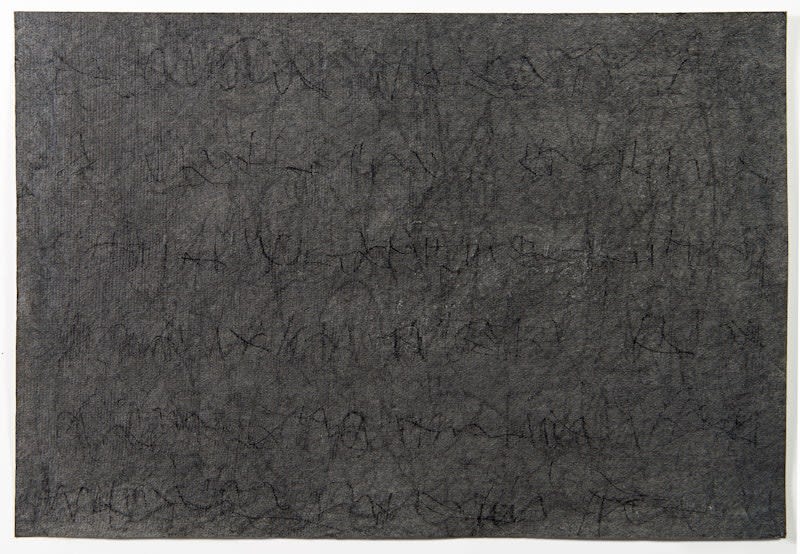Looking at images of Raquel Rabinovich’s Avatars on a screen in any reproductive format is to wrestle with the impossible. Encountering this recent body of work by the ninety-five-year-old artist is deeply moving, as though I were witnessing the distilled essence and summation of a creative lifetime. Her artistic engagement in transforming earthen materials like mud, silt, and stone into unfathomable dynamic spaces reflects her mastery of touch. Approaching Hutchinson Modern & Contemporary, I felt strangely unprepared, as I have only seen her works online. A discrete stair leading downwards opens into an underground space where “Avatars” hover like dark mouths on the walls. No larger than 30 by 48 inches, their soft power swelled and opened as I drew near. This is a descent into the unknown, an encounter with undefined language, and an artist whose internal voyage culminates in these works. This body of work is cause for meditation.
“Avatars” cannot exist outside of their materiality; however, this materiality is in question. The disarmingly fluid surfaces unfold from the dark and immediate color palette. At first, the works seem hard like slate, but with time give into broadening fields. These spaces are alive and changing, as though moving with the viewer’s own vitality and will. An indecipherable script sprouts like grasses or hair from the subtle atmosphere of the paintings. The density of the brush marks congeals like alto-cumulous clouds, organizing themselves as gills sifting air, veined with cracks revealing brighter reds, blues, greens, yellows deeper in. This is not like the thick paint handling of Richard Serra’s black works, or Ad Reinhart’s spaceless black geometric paintings. It is closer to Jack Whitten’s investigations of material sensibility for the creation of spiritual units. Rabinovich seems to be taking all that has been learned from previous works and expanding upon it. Avatars specifically recalls the glowing atmospheres of Rabinovich’s painting series “Dimension Five” (1970s) and the freeform script of the more recent works on paper, “When Silence Becomes Poetry.” We encounter a quiet, liminal space that can neither be described as interior or exterior, self or other.
The drawings feel more intimate, more human, like the generativity of unspecified thought. Subtle, energetic linework flickers through the ink, manganese, and charcoal washes saturating the paper. These mystifying marks, near handwriting, escape literal discourse and systems of organized thought. There is no hesitancy in their line because they have a fluidity of purpose. I’m reminded of the calligraphic works of Mark Tobey rendered layer upon layer. Both deal with script as raw form, devoid of translatability, building up into intricate compositions. While Tobey works with light, Rabinovich grounds the work in darkness, with breathing room.
Radically generous, the “Avatars” never feel fixed. The artworks occupy a psychic field where physics and poetic flights can co-exist. They are siblings in flesh, they easily seam one into the next. The slight differences make for very different entrances into the works. For example, in Avatars 3 (2023) and Avatars 8 (2023), rhythmic scripts begin to fade and lose focus as my eye works down the surface. There is more mist and obscurity to the opening voids of the paintings. Avatars 2 (2023) and Avatars 10 (2023) have clearer weather. These weathered scapes provide space for viewers to insert their own experiences, imaginations, and doubts, to let them congregate and form relationships. But all at once these meetings can fall apart. This counter produces communicative information, there is no coercion. Just as the script wisps into the air of the artworks, intriguing some representation denied, nothing has solidified beyond the object of the painting itself. Avatars is in collaboration with me, in irresolution.
These works are diffusers, their space expands inseparably with the viewer’s engagement or suspension or entanglement. The title Avatars, in Sanskrit, means descent. The work unfurls and folds, animates and holds. They do not emanate into the spaces they inhabit, rather they depress, invaginate into other dimensions like nests, summoning the first stanza of “Germantown” in Rachel Mannheimer’s Earth Room (2022):
The turtle was beside the pond,
ground muddied around her. Slowly, she lowered
one hind leg, then the other,
hollowing a hole
in which to lay her eggs below her.
If the paint is mud, we can push, lay, release our own shapes into the mix in regeneration or burial. Unearthing and ungrounding suspend all the qualities that are mixed up, a meditation on the suspicion of hidden value.
______________________
Mary Smith
Mary Smith is an artist, writer, and professor of fine arts at MICA in Baltimore, Maryland.
The viewer falls into the unlocalized spaces of Avatars. We can revisit the artist’s previous explorations, such as “River Library” (2002–present), in the liveliness and enrichment of earthen materials. Rabinovich is a historian of sediments. This body of work denies the formalization of data, but rather opens continuously to new pathways and spaces of possibility. In these works, we feel the artist is writing a new chapter, sourced from years of development.



